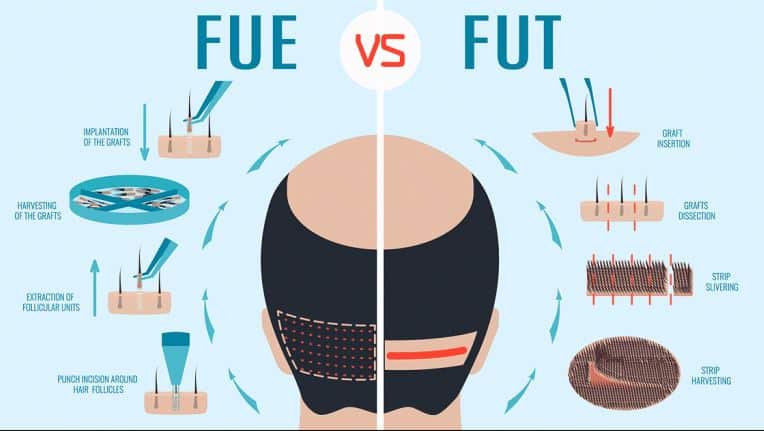FUE vs. FUT Hair Transplant Surgery?

Did you know there are two types of hair transplant harvesting methods? While both methods have the same goal of moving strong, permanent hair follicles from the safe donor area on the sides and back of the scalp to the thinning and balding regions (recipient area), the methods differ in the way the hair is harvested.
During a Follicular Unit Transplantation, sometimes called “FUT” or “strip,” procedure, a small strip of hair-bearing skin is removed from the donor area. The defect created by the harvest is immediately closed with stitches or staples, and heals into a fine, difficult to appreciate linear scar. The “strip” is then dissected into individual follicular units under high powered microscopes, and those follicular units — or “grafts” — are transplanted individually into the recipient area.
During a Follicular Unit Excision, or “FUE,” procedure, small, punch tools are used to carefully cut around individual follicular units “one-by-one” in the donor region. After cutting around a unit, forceps (medical tweezers) are used to “pluck” the graft free. The small holes created by graft removal are left open and heal into “dot” scars in the donor region. The graft is then examined under a microscope and implanted into the recipient region just like in an FUT procedure.
So, now you know that there are two different modern hair transplant harvesting methods. But what does this mean for you as a patient? Which technique is best for your case? What are the advantages and disadvantages of each technique? And, most importantly, which one will provide the best results?
To help answer these questions, and discuss FUE vs. FUT harvesting in general, Dr. Richard Powell of Miami, Florida put together an educational video for our popular YouTube channel. In the video, which can be viewed below, Dr. Powell first describes the differences in the harvesting techniques. He then helps explain the “pros and cons” of both harvesting methods, and helps patients determine which approach may be best for their case.
While we do recommend all patients watch the full video, here are a few “bullet points” to help understand the advantages and disadvantages of FUE and FUT, and help patients decide which approach may be best for their case.
FUT
Advantages:
- Allows for the greatest number of grafts to be harvested safely in a single sitting
- Causes the least amount of damage in the donor area, and provides the ability to undergo more surgeries at a later date
- Maximizes the number of life-time grafts a patient can utilize
- Allows for the highest quality grafts due to the a-traumatic harvesting process and microscopic dissection
- Boasts the highest growth yield (95-98% successful growth rate)
- Minimizes shaving required during surgery
- Greatest “track record” of quality, consistent results
Disadvantages:
- May not be suitable for patients with “tight” scalps; some “laxity” required in the donor area for proper strip harvest
- A permanent linear scar is left behind in the donor area. While the scar is typically very small (1-2mm) and difficult to appreciate, it is visible if you shave the hair low. Most patients can go down to a #3 on the hair clippers before it is visible
- Not all clinics can offer FUT. Clinics must be a dedicated, stand-alone hair transplant institute with a large, well-trained staff to offer FUT. This means patients may need to travel for FUT surgery.
Patients Best Suited for FUT:
Almost all patients are good patients for FUT. It is the “gold standard” of hair transplant surgery, and there are very few exceptions where FUT cannot be recommended in good conscience. However, some patients well-suited for FUT include: patients who require large sessions; patients who may need another surgery at a later date; young patients with uncertain hair loss futures; patients requiring work in crucial areas, like the hairline, where the best growth is paramount; patients who wear their hair longer on the sides regardless; and patients who insist upon the best chance at a good result.
FUE
Advantages:
- FUE, just like FUT, leaves permanent scarring in the donor region. However, the scarring consists of very small (1mm) dots. When spread far apart, these dots are difficult to appreciate and most patients can go shorter on the buzzer (down to a #2) before the scars are apparent. This means patients who have FUE can usually have shorter hair styles
- No stitches or staples are used in the donor region, so patients do not need to have these removed
- Ability to harvest in patients with tight scalps. Patients who had prior strip surgeries and can no longer undergo further strip harvesting can also “switch” to FUE and remove more grafts as well. We are also able to access additional portions of the donor area where we cannot access with FUT alone.
Disadvantages
- Smaller numbers of grafts can be safely harvested in one sitting. We recommend no more than 1,500.
- Poorer graft quality. This is because the grafts undergo additional trauma during the extraction process.
- Lower growth yield. This is due to extra trauma during removal, a “stripping” of supportive tissue surrounding the follicles compared to FUT grafts, and excess “out of body” time (grafts sit out of the body longer during an FUE procedure)
- Less efficient use of the donor region. FUE reduces the number of grafts patients can remove from the donor area over a life-time.
- More damage in the donor region. Diffuse harvesting creates damage throughout the entire donor region. This affects everything from vascularity (blood supply) to innervation (nerve supply), and negatively impacts future surgeries.
- “Over-Harvesting,” or removing too many FUE grafts at a time, leads to a thin, patchy appearance in the donor which cannot be hidden (even with longer hair)
- Less consistent results compared to FUT surgery
Patients Best Suited for FUE:
Patients only requiring a small graft number; patients with “tight” scalps or patients who have undergone prior strip surgeries in the past and can no longer have more strip harvesting; patients who want to wear their hair shorter on the sides; patients who only require one surgery; patients working in less cosmetically visible regions of the scalp; older patients with more certain hair loss futures; and patients with hair characteristics which may tolerate the trauma of FUE extraction well.
Interested in learning more? If so, please watch the following video:
________
Dr. Blake Bloxham
Feller & Bloxham Medical, PC





